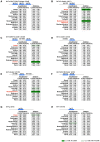Genomic DNA copy-number alterations of the let-7 family in human cancers
- PMID: 22970210
- PMCID: PMC3435307
- DOI: 10.1371/journal.pone.0044399
Genomic DNA copy-number alterations of the let-7 family in human cancers
Abstract
In human cancer, expression of the let-7 family is significantly reduced, and this is associated with shorter survival times in patients. However, the mechanisms leading to let-7 downregulation in cancer are still largely unclear. Since an alteration in copy-number is one of the causes of gene deregulation in cancer, we examined copy number alterations of the let-7 family in 2,969 cancer specimens from a high-resolution SNP array dataset. We found that there was a reduction in the copy number of let-7 genes in a cancer-type specific manner. Importantly, focal deletion of four let-7 family members was found in three cancer types: medulloblastoma (let-7a-2 and let-7e), breast cancer (let-7a-2), and ovarian cancer (let-7a-3/let-7b). For example, the genomic locus harboring let-7a-3/let-7b was deleted in 44% of the specimens from ovarian cancer patients. We also found a positive correlation between the copy number of let-7b and mature let-7b expression in ovarian cancer. Finally, we showed that restoration of let-7b expression dramatically reduced ovarian tumor growth in vitro and in vivo. Our results indicate that copy number deletion is an important mechanism leading to the downregulation of expression of specific let-7 family members in medulloblastoma, breast, and ovarian cancers. Restoration of let-7 expression in tumor cells could provide a novel therapeutic strategy for the treatment of cancer.
Conflict of interest statement
Figures





Similar articles
-
Frequent overexpression of HMGA2 in human atypical teratoid/rhabdoid tumor and its correlation with let-7a3/let-7b miRNA.Clin Cancer Res. 2014 Mar 1;20(5):1179-89. doi: 10.1158/1078-0432.CCR-13-1452. Epub 2014 Jan 14. Clin Cancer Res. 2014. PMID: 24423609
-
Copy number and expression alterations of miRNAs in the ovarian cancer cell line OVCAR-3: impact on kallikrein 6 protein expression.Clin Chem. 2013 Jan;59(1):296-305. doi: 10.1373/clinchem.2012.193060. Epub 2012 Nov 7. Clin Chem. 2013. PMID: 23136250
-
PRB inhibited cell proliferation through let-7b-E2F1 in breast cancer.Endocr Relat Cancer. 2023 Jun 22;30(7):e220204. doi: 10.1530/ERC-22-0204. Print 2023 Jul 1. Endocr Relat Cancer. 2023. PMID: 37130271
-
A glimpse into let-7e roles in human disorders; friend or foe?Pathol Res Pract. 2024 Jan;253:154992. doi: 10.1016/j.prp.2023.154992. Epub 2023 Nov 29. Pathol Res Pract. 2024. PMID: 38103367 Review.
-
Cancer type-specific alterations in actin genes: Worth a closer look?Int Rev Cell Mol Biol. 2021;360:133-184. doi: 10.1016/bs.ircmb.2021.02.017. Epub 2021 Mar 30. Int Rev Cell Mol Biol. 2021. PMID: 33962749 Review.
Cited by
-
miRNA let-7b modulates macrophage polarization and enhances tumor-associated macrophages to promote angiogenesis and mobility in prostate cancer.Sci Rep. 2016 May 9;6:25602. doi: 10.1038/srep25602. Sci Rep. 2016. PMID: 27157642 Free PMC article.
-
Rewiring macrophages for anti-tumour immunity.Nat Cell Biol. 2016 Jun 28;18(7):718-20. doi: 10.1038/ncb3384. Nat Cell Biol. 2016. PMID: 27350442
-
The deregulated microRNAome contributes to the cellular response to aneuploidy.BMC Genomics. 2018 Mar 14;19(1):197. doi: 10.1186/s12864-018-4556-6. BMC Genomics. 2018. PMID: 29703144 Free PMC article.
-
Impact of Nutrition on Non-Coding RNA Epigenetics in Breast and Gynecological Cancer.Front Nutr. 2015 May 27;2:16. doi: 10.3389/fnut.2015.00016. eCollection 2015. Front Nutr. 2015. PMID: 26075205 Free PMC article. Review.
-
MicroRNAs at the Crossroad of the Dichotomic Pathway Cell Death vs. Stemness in Neural Somatic and Cancer Stem Cells: Implications and Therapeutic Strategies.Int J Mol Sci. 2020 Dec 17;21(24):9630. doi: 10.3390/ijms21249630. Int J Mol Sci. 2020. PMID: 33348804 Free PMC article. Review.
References
-
- Ambros V, Horvitz HR (1984) Heterochronic mutants of the nematode Caenorhabditis elegans. Science 226: 409–416. - PubMed
-
- Ambros V, Moss EG (1994) Heterochronic genes and the temporal control of C. elegans development. Trends Genet 10: 123–127. - PubMed
-
- Moss EG (2007) Heterochronic genes and the nature of developmental time. Curr Biol 17: R425–434. - PubMed
-
- Slack F, Ruvkun G (1997) Temporal pattern formation by heterochronic genes. Annu Rev Genet 31: 611–634. - PubMed
Publication types
MeSH terms
Substances
Grants and funding
LinkOut - more resources
Full Text Sources

